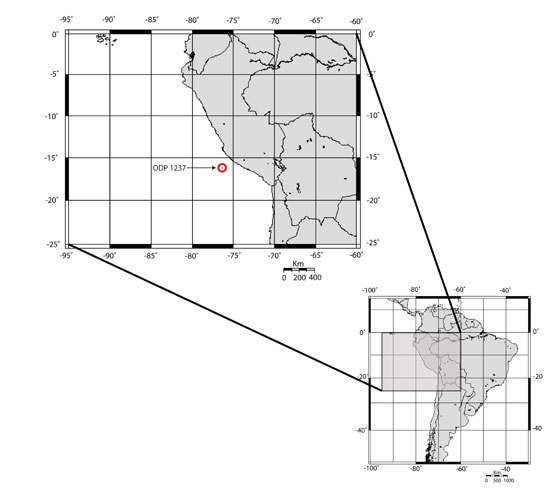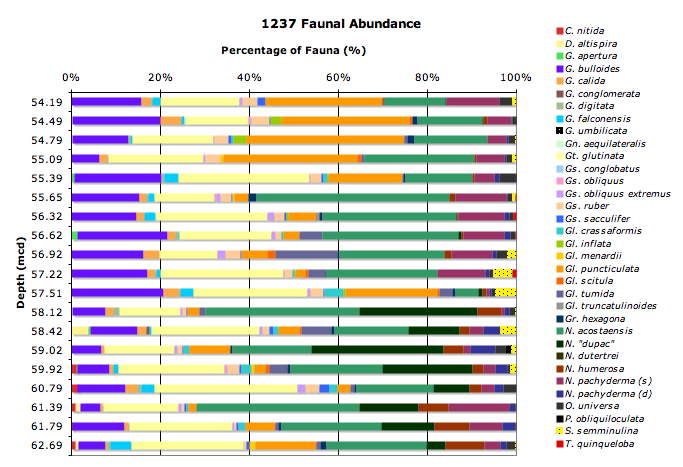USGS Data Series 336
By Rocio Caballero and Harry Dowsett
The U.S. Geological Survey is conducting a long-term study of mid-Pliocene climatic and oceanographic conditions. One of the key elements of the study involves the use of quantitative composition of planktic foraminifer assemblages in conjunction with other proxies to constrain estimates of sea-surface temperature (SST) and to identify major oceanographic boundaries and water masses.
Raw census data are made available as soon as possible after analysis through a series of reports that provide the basic data for future work. In this report we present raw census data (table 1) for planktic foraminifer assemblages in 19 samples from Ocean Drilling Program (ODP) Hole 1237C. ODP Hole 1237C is located on the Peruvian margin at 16° 0.4216'S., 76° 22.6854'W., in 3211.9 meters of water (fig. 1).

Figure 1. Location of Ocean Drilling Program Site 1237.
Table 1. Planktic foraminifer census data, Ocean Drilling Program Hole 1237C: HTML | Excel
A variety of statistical methods have been developed to transform foraminiferal census data in Pliocene sequences into quantitative estimates of Pliocene SST. Details of statistical techniques, taxonomic groupings, and oceanographic interpretations are presented in more formal publications (Dowsett and Poore, 1990, 1991; Dowsett, 1991, 2007; Dowsett and Robinson, 1998, 2007; Dowsett and others, 1996, 1999).
Sediment samples used in this study were oven dried at <=50°C. The dried bulk samples were disaggregated in 250 milliliters of warm tap water with ~2 milliliters of dilute sodium hexametaphosphate (5 grams per liter water). The samples were agitated for 1 hour at room temperature and then washed over a 63 micrometer sieve using a fine spray hose. The coarse fraction was dried in an oven at <=50°C. Some samples required an additional wash cycle to obtain clean specimens. A split of 300-350 planktic foraminifer specimens was obtained from the <=150 micrometer size fraction using a CarpcoTM sample splitter. Specimens were sorted, identified, and glued to 60-square micropaleontological slides.
In general, our taxonomic concepts follow Parker (1962; 1967) and Blow (1969); exceptions to their practices are documented in Dowsett and Robinson (2007). ODP sample designations are abbreviated in table 1 as core section, depth within section in centimeters (for example, 10-5, 34-35 cm = core 10, section 5, 34-35 centimeters below the top of section 5). The depth columns list depth of sample below the sea floor in meters and a composite depth scale. Figure 2 presents the faunal abundance in percent for each sample.

Figure 2. Planktic foraminifer relative abundances, Ocean Drilling Program Hole 1237C. Abbreviation: mcd, meters composite depth.
We thank Marci Robinson and Debra Willard for reviewing this manuscript. We thank the Ocean Drilling Program for access to the samples. This report is a product of the U.S. Geological Survey Earth Surface Dynamics Program.
Any use of trade, product, or firm names is for descriptive purposes only and does not imply endorsement by the U.S. Government. Although this report is in the public domain, permission must be secured from the individual copyright owners to reproduce any copyrighted materials contained within this report.
Blow, W.H., 1969, Late middle Eocene to Recent planktonic foraminiferal biostratigraphy, in Bronnimann, P., and Renz, H.H., eds., Proceedings of First International Conference on Planktonic Microfossils, Geneva, 1967: Leiden, Netherlands, E.J. Brill, v. 1, p. 199-422.
Dowsett, H.J., 1991, The development of a long-range foraminifer transfer function and application to Late Pleistocene North Atlantic climatic extremes: Paleoceanography v. 6, p. 259-273.
Dowsett, H.J., 2007, The PRISM palaeoclimate reconstruction and Pliocene sea-surface temperature, in Williams, M., Haywood, A., and Gregory, J., eds., Deep time perspectives on climate change: Marrying the signal from computer models and biological proxies: The Micropalaeontological Society, Special Publications, The Geological Society, London, p. 407-428.
Dowsett, H.J., Barron, J.A., and Poore, R.Z., 1996, Middle Pliocene sea surface temperatures: A global reconstruction, in Poore, R.Z., and Sloan, L.C., eds., Climates and climate variability of the Pliocene: Marine Micropaleontology v. 27, no. 1-4, p. 13-26.
Dowsett, H.J., Barron, J.A., Poore, R.Z., Thompson, R.S., Cronin, T.M., Ishman, S.E., and Willard, D.A., 1999, Middle Pliocene paleoenvironmental reconstruction: PRISM2: U.S. Geological Survey Open-File Report 99-535, available online at https://pubs.usgs.gov/of/1999/of99-535.
Dowsett, H.J., and Poore, R.Z., 1990, A new planktic foraminifer transfer function for estimating Pliocene-Holocene paleoceanographic conditions in the North Atlantic: Marine Micropaleontology, v. 16, no. 1-2, p. 1-23.
Dowsett, H.J., and Poore, R.Z., 1991, Pliocene sea surface temperatures of the North Atlantic Ocean at 3.0 Ma: Quaternary Science Reviews, v. 10, no. 2-3, p. 189-204.
Dowsett, H.J., and Robinson, M.M., 1998, Application of the modern analog technique (MAT) of sea surface temperature estimation to middle Pliocene North Pacific planktic foraminifer assemblages: Palaeontologia Electronica, v. 1, no. 1, 22 p., available online at http://palaeo-electronica.org/1998_1/dowsett/issue1.htm.
Dowsett, H.J., and Robinson, M.M., 2007, Mid-Pliocene planktic foraminifer assemblage of the North Atlantic Ocean: Micropaleontology, v. 53, no. 1-2, p. 105-126.
Parker, F.L., 1962, Planktonic foraminiferal species in Pacific sediments: Micropaleontology, v. 8, no. 2, p. 219-254.
Parker, F.L., 1967, Late Tertiary biostratigraphy (planktonic foraminifera) of tropical Indo-Pacific deep-sea cores: Bulletins of American Paleontology, v. 52, no. 235, p. 115-208.
Caballero, Rocio, and Dowsett, Harry, 2008, Mid-Pliocene planktic foraminifer census data from Ocean Drilling Program Hole 1237C: U.S. Geological Survey Data Series 336, available only online at https://pubs.usgs.gov/ds/336.